Stadium History
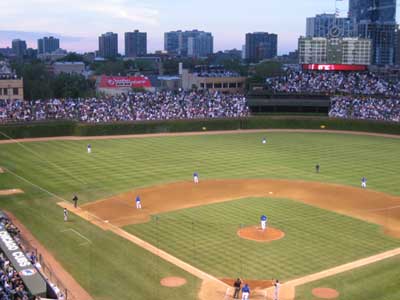 Built in 1914 for the sizable sum of $250,000, Wrigley Field is now the oldest ballpark in the National League. The park was designed by famed architect Zachary Taylor Davis, who also designed the original Comiskey Park on Chicago's South Side. Many consider seeing a game at Wrigley to be a religious experience, which may be because the park was built on the site of a former seminary.
Built in 1914 for the sizable sum of $250,000, Wrigley Field is now the oldest ballpark in the National League. The park was designed by famed architect Zachary Taylor Davis, who also designed the original Comiskey Park on Chicago's South Side. Many consider seeing a game at Wrigley to be a religious experience, which may be because the park was built on the site of a former seminary.
Originally known as Weeghman Park, the stadium on Chicago's North Side was home to the Chicago Federals when the first baseball game was played there in April of 1914. Charlie Weeghman built the park to house the Federals, later known as the Whales, who were members of the newly-formed Federal League that was trying to compete with Major League Baseball. The Federal League caused the normally tight-wad owners in Major League Baseball to begrudgingly increase players salaries to keep the best baseball players from bolting to the Federal League, but the Federal League folded after the 1915 season and owners immediately returned player salaries to their pre-Federal League levels. After the Federal League folded Weeghman teamed up with nine other men, including chewing gum tycoon William Wrigley, Jr., to purchase the Chicago Cubs from the Taft family of Cincinnati. The team was moved from West Side Grounds to Weeghman Park, and played their first game on April 20th, 1916 against the Cincinnati Reds. The Cubs won in 11 innings with a bear cub watching in attendance. In 1920 the Wrigley family purchased the team outright, and renamed the stadium Cubs Park. The name was changed for good in 1926 when it was named to honor William Wrigley, Jr.
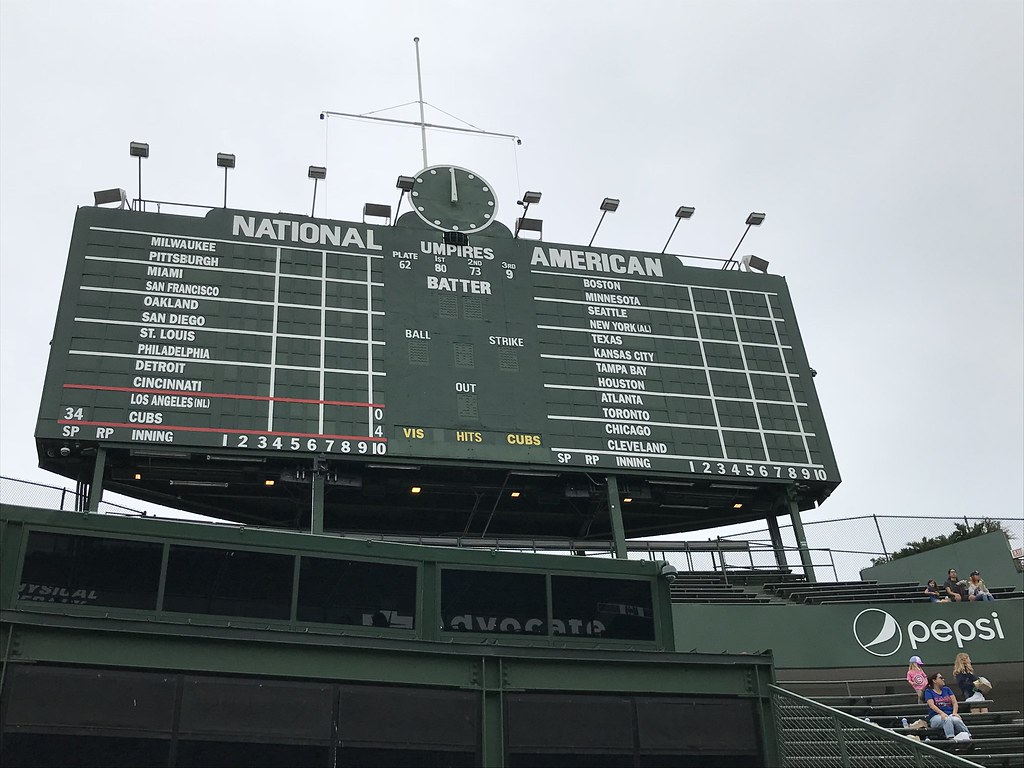 In 1937 Bill Veeck, who would eventually go on to own the Chicago White Sox, St. Louis Browns, and Cleveland Indians at different times in his career, supervised the construction of the famous outfield scoreboard, which to this day has never been struck by a batted ball, although Roberto Clemente and Bill Nicholson both came close. Sam Sneed did hit the scoreboard from home plate, but he was using a driver and hitting a golf ball off a tee. A number of flags fly atop the scoreboard to show the current NL standings, and after a game a white flag with a blue "W" or a blue flag with a white "L" flies in their place to show El commuters whether the Cubs won or lost that day. 1937 was the same year the trademark ivy was placed on the outfield wall. Bill Veeck strung 350 Japanese Bittersweet plants from the top of the wall to the bottom, and also planted 200 Boston Ivy plants at the base of the wall. Eight Chinese Elm trees were also planted on the bleacher steps at this time to complement the ivy, but the winds blowing off of Lake Michigan kept the trees bare so they were removed. There were only a few major changes since that time. One major change was the reconstruction of the bleachers after the 2005 season. This expansion added 1,800 seats to the outfield, a private restaurant in center field called the Batter's Eye Lounge, and a gate on the outside of the stadium that allows passersby to see onto the field. One of the other major changes to Wrigley occurred in August of 1988, and it was a change that would affect Cubs' games for years to come.
In 1937 Bill Veeck, who would eventually go on to own the Chicago White Sox, St. Louis Browns, and Cleveland Indians at different times in his career, supervised the construction of the famous outfield scoreboard, which to this day has never been struck by a batted ball, although Roberto Clemente and Bill Nicholson both came close. Sam Sneed did hit the scoreboard from home plate, but he was using a driver and hitting a golf ball off a tee. A number of flags fly atop the scoreboard to show the current NL standings, and after a game a white flag with a blue "W" or a blue flag with a white "L" flies in their place to show El commuters whether the Cubs won or lost that day. 1937 was the same year the trademark ivy was placed on the outfield wall. Bill Veeck strung 350 Japanese Bittersweet plants from the top of the wall to the bottom, and also planted 200 Boston Ivy plants at the base of the wall. Eight Chinese Elm trees were also planted on the bleacher steps at this time to complement the ivy, but the winds blowing off of Lake Michigan kept the trees bare so they were removed. There were only a few major changes since that time. One major change was the reconstruction of the bleachers after the 2005 season. This expansion added 1,800 seats to the outfield, a private restaurant in center field called the Batter's Eye Lounge, and a gate on the outside of the stadium that allows passersby to see onto the field. One of the other major changes to Wrigley occurred in August of 1988, and it was a change that would affect Cubs' games for years to come.
After Crosley Field in Cincinnati installed lights in 1935 many other teams began to cash-in on the phenomenon that was nighttime baseball. The Cubs were one of these teams, and in 1941 lights were purchased and were prepared to be installed at Wrigley. When Pearl Harbor was bombed, however, the Wrigley family decided the next day to donate the lights to a shipyard to support the war effort. The Wrigley family was one of the major corporate supporters of the war effort, and donated tons of gum, which was considered a war ration, to the troops. After World War II baseball wasn't in as much of a financial crisis as it was before the war so lights weren't discussed again at Wrigley until the late 80's when Cubs management insisted the team's future at Wrigley was in jeopardy if lights weren't installed. The final straw was when Major League Baseball said the Cubs would be forced to play playoff games at Busch Stadium in St. Louis if they didn't install lights at Wrigley. The Cubs weren't about to play in the home of their bitter rival, so lights were installed at Wrigley Field in 1988. The first scheduled night game was on August 8th, 1988 against the Philadelphia Phillies, but it was rained out after 3½ innings. The first official game took place the next night against the New York Mets, which the Cubs won 6-4.
 Wrigley Field has been the origin of many popular baseball traditions. The first permanent concession stand was built at Weeghman Park in 1914 where it sold overpriced hot dogs and beer. It is said William Wrigley Jr. started the custom of allowing fans to keep foul balls, but that presumption is disputed by the Phillies who believe the tradition started in Philadelphia after a young fan was arrested for keeping a foul ball as a souvenir. In either case, the custom of fans throwing back opponent's homerun balls certainly started at Wrigley, and it continues today. Fans will even throw balls hit out of the stadium back from Waveland or Sheffield Avenues, to the chagrin of Reds' announcer Marty Brennaman. Many of the balls thrown back are more than likely not the original balls hit out, but it is the action of throwing the ball back that counts. The tradition of singing "Take Me Out To The Ballgame" began at Wrigley, and was sung by venerable broadcaster Harry Caray from 1982 until his death before the 1998 season. His grandson Chip Caray took over in the broadcast booth from 1998 until 2004, and a cavalcade of celebrities and Chicagoans have sung the song since Harry's death. The tradition of signing the National Anthem before every game also began at Wrigley when it was first sung before the 1918 World Series. Wrigley was also the first field with an organist in 1941, and is one of the few fields to still play organ music more than popular music through the sound system. Although more than half the fields in baseball have organs many of those organs don't get much use.
Wrigley Field has been the origin of many popular baseball traditions. The first permanent concession stand was built at Weeghman Park in 1914 where it sold overpriced hot dogs and beer. It is said William Wrigley Jr. started the custom of allowing fans to keep foul balls, but that presumption is disputed by the Phillies who believe the tradition started in Philadelphia after a young fan was arrested for keeping a foul ball as a souvenir. In either case, the custom of fans throwing back opponent's homerun balls certainly started at Wrigley, and it continues today. Fans will even throw balls hit out of the stadium back from Waveland or Sheffield Avenues, to the chagrin of Reds' announcer Marty Brennaman. Many of the balls thrown back are more than likely not the original balls hit out, but it is the action of throwing the ball back that counts. The tradition of singing "Take Me Out To The Ballgame" began at Wrigley, and was sung by venerable broadcaster Harry Caray from 1982 until his death before the 1998 season. His grandson Chip Caray took over in the broadcast booth from 1998 until 2004, and a cavalcade of celebrities and Chicagoans have sung the song since Harry's death. The tradition of signing the National Anthem before every game also began at Wrigley when it was first sung before the 1918 World Series. Wrigley was also the first field with an organist in 1941, and is one of the few fields to still play organ music more than popular music through the sound system. Although more than half the fields in baseball have organs many of those organs don't get much use.
A lot of baseball history has taken place at Wrigley even though the park has never seen a Cubs World Series Championship. One of the most legendary games at Wrigley was the 1917 pitching duel between Jim 'Hippo' Vaughn and Fred Toney of the Cincinnati Reds. Both had no-hitters through nine innings, a feat that has never been duplicated, and Toney finished his no-hitter after Jim Thorpe of the Reds broke up Vaughn's no-hitter in the 10th inning. Another no-hitter took place in 1972, but many believe it should have been a perfect game. The Cubs' Milt Pappas had retired 26 San Diego batters when a controversial ball call by the umpire caused the batter to walk with two outs in the 9th inning. In the 1932 World Series the most famous event at Wrigley occurred, probably, when Babe Ruth pointed to the outfield bleachers before parking a ball pitched by Charlie Root into the very section he pointed to. Most people don't dispute the fact that Ruth pointed, but whether it was a "called shot" is a matter that will probably never be decided, and it only adds to the mystique of The Babe and the game of baseball. On September 28 of 1938 a crucial game between the Cubs and the Pittsburgh Pirates was minutes away from being postponed because of darkness when Cubs' catcher Gabby Hartnett hit his famous "Homer in the Gloamin'" off Mace Brown to lift the Cubs to the division title. Wrigley Field has also seen Ernie Banks' 500th homerun off Atlanta's Pat Jarvis, Pete Rose's 4,191st hit off Reggie Patterson, which tied him with Ty Cobb for the most in baseball history, Kerry Wood's 20-strikeout game in 1998 against the Houston Astros, and Sammy Sosa's 60th homeruns in 1998, 1999, and 2001. Wrigley has hosted the All-Star Game in 1947, 1962, and 1990, and has seen World Series action in 1918, 1929, 1932, 1935, 1938, and 1945. Andy Pafko, the only Chicago Cub still alive from the 1945 World Series team, hopes he can see a Cubs World Series victory so he, and millions of other Cubs fans, can finally root for a winner.
Heard At The Ballpark
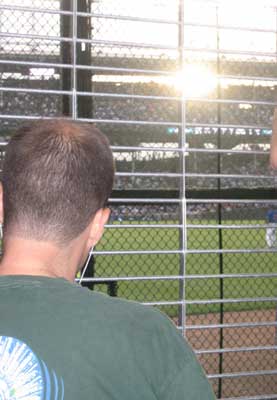 "I'd pay half my salary if I could bat in this dump all the time."
"I'd pay half my salary if I could bat in this dump all the time."
- Babe Ruth before the 1932 World Series
"Wrigley is like another home in the community. When you're in Wrigley Field it's like you're visiting the family of all the people that live around here."
- "Mr. Cub," Ernie Banks
"Wrigley Field was my favorite place to play because I would much rather play day games and I loved to smell the bratwurst."
- Phil Niekro, Atlanta Braves' Hall of Famer
"Ivy on the walls, crazy fans in the bleachers, not much room outside the foul lines, the fans right on top of you. The pitcher can hear them yelling at him. The Cubs get used to that, just like the crummy weather in April."
- Mark Grace, Cubs' 1st Baseman for 13 years
"When this place is gone, there will never be another to replace it." - Ernie Harwell, legendary Detroit Tigers' broadcaster
"Day ball, night ball, it doesn't matter. There's no place that can match Wrigley Field. It's just one of the few old shrines that still belongs to the fans."
- Don Zimmer, Cubs' Manager from 1988 to 1991
"It's always been my favorite place to go...it's the head of the class for some reason. I can't put my finger on it. It just seems like it should never be touched. It's too much of a treasure."
- Atlanta Braves Manager Bobby Cox
"I loved to play at Wrigley Field in Chicago. The fans were very close to the players."
- Orlando Cepeda, Hall of Famer for the San Francisco Giants
"This place is like a cathedral. It's the baseball version of St. Patrick's Cathedral. It's something people have seen and been to and have been associated with for not only their lifetime, but their parents' lifetimes, too. You just cannot replace this type of ballpark."
- Ed Lynch, General Manager of the Cubs from 1995 to 2000
"The first time I tried it with the lights on, it was pretty much a washout, too."
- David Letterman, after the first night game at Wrigley was rained out
Getting There

Getting to Wrigley is a snap if you don't drive. Driving isn't too big of an issue getting to the stadium aside from the fact that you will pay around $30 anywhere you try to park (-1), but leaving Wrigley afterwards can be a hassle as you have to get to your parking lot, where you may or may not be boxed in by cars that parked after you, and then weave through the mass of drunken fans, CTA busses, charter busses from out-of-state, and people who just don't know how to drive (-1). Don't think about parking on the streets either since Chicago's traffic cops are not known for slacking off and you will get towed since all the parking in Wrigleyville is permit-only (-1). One of the best ways to get the Wrigley is to take the L's Red Line (+1), which drops you off less than a block from the park. It's quick, easy, and not nearly as crowded as the subways of New York (+1) even though just about every Cubs' game is sold out. It can get crowded when you leave the game, but take the L north for one stop and come back down to outsmart the crowds. There are also a number of charter busses from places in the suburbs and DeVry University (+1), but I've never taken advantage of those.
Score: 5/10
Tickets and Seating
Tickets at Wrigley can be pretty pricey (-1), and there is a very confusing pricing schedule that you might need an advanced degree in economics to understand. Ticket prices are higher on weekends, and higher still if the game is a "platinum date" such as a game against the White Sox or Cardinals. Overall, the tickets at Wrigley are among the most expensive in baseball with box seats ranging from $25 to $350 (-1). The "bronze dates" are the most reasonable with tickets maxing out at $100, but tickets for "gold" and "silver" dates still can be pretty expensive ranging from $16 for the upper deck to $325 for the best box seats. If you can't get tickets there are dozens of ticket brokers (+1) around Wrigley, but when the Cubs are playing well you may find yourself paying upwards of $100 just for a seat in the upper deck. However, the ticket pricing schedule can be alleviated by the fact that just about every seat in Wrigley is a good spot to watch the action on the field (+1). There are a few obstructed view seats in the park behind the support beams for the upper deck (-1), but these seats are few and far between and the Cubs let you know ahead of time that these seats are obstructed view when you are purchasing them (+1). The support beams are essential, though, as they allow the upper deck to be much closer to the action than it would have been without them (+1). I say having a few obstructed view seats is much better than having an upper deck far away from the action. Pretty much anywhere you sit in Wrigley allows you to see, and hear, everything happening on the field (+1). This got former manager Dusty Baker in trouble once when some fans didn't like the words he used during a tirade with an umpire in 2004.
Score: 7/10
Exterior

Wrigley Field used to be pretty bland from the outside with tan concrete outlined by green supports, but the stadium has improved quite a bit in the past few years. It has more character than the exterior of most stadiums after the recent additions (+1). The main entrance of the park is classic with the red marquee saying "Wrigley Field Home of Chicago Cubs" with an electronic marquee displaying information about the next Cubs' game or other Cubs' news of note (+1). Near the main entrance you will also find a few baseball diamonds in the sidewalk celebrating famous Cubs' players as well as bricks with dedications from Cubs fans as well as a statue of Ernie Banks with his famous smile (+1). You can also find the statues of broadcaster Harry Caray, left fielder Billy Williams, and third baseman Ron Santo. After the expansion of the bleachers in 2005 a gate known as "the Knothole" was added under the bleachers on Sheffield that allows fans to see inside the park during games (+1). The Cubs have said they won't prevent fans from staying at the gate for an entire game if they want, but they are banking on the fact that most fans will just stay for a few minutes since it only allows a limited view of the field. The Cubs attempted to grow ivy outside the stadium, but that didn't work out so the plan was abandoned. In 2017, the Cubs opened the Park at Wrigley that allows fans with tickets a place to hang out before the game starts (+1).
Score: 10/10
Interior
Wrigley Field is by far the most beautiful ballpark once you enter its Friendly Confines. The ivy on the brick outfield wall is much more aesthetically pleasing than the padded walls that most parks have (+1), although the ivy-covered brick is probably a little less forgiving than padded walls for the outfielders. The views of Chicago are vastly different depending on where you are sitting (+1). From the lower decks you can see all that Wrigleyville has to offer from the surrounding apartment complexes with fan seating on each roof to the famous ads just outside the park. One of these apartments has a sign saying "EAMUS CATULI," or "Let's Go Cubs" in Latin (+1), or, more literally, "Let's Go Young Bears." Another sign looks even more cryptic and says "AC006299." The "AC" stands for "After Championship," and the numbers as of the 2008 season mean it has been 0 years since a Cubs' division championship, 62 years since a World Series appearance, and 99 years since a World Series championship. In the upper deck inside Wrigley you get a great view of those same apartments as well as the lake, and the bleachers will give you arguably the best view of them all with a good look at downtown Chicago (+1). Everywhere you look inside the park you see red brick and green paint (+1), a classic look that will hopefully never die, and seems to be coming back in some of the newer parks.
Score: 10/10
Scoreboard
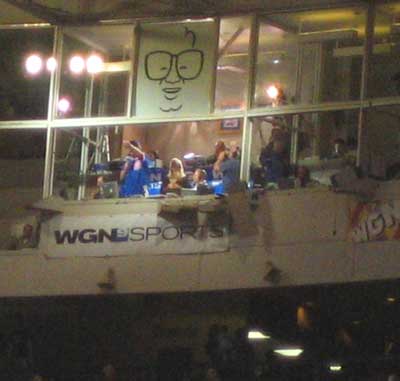
The Wrigley Field scoreboard has been a part of Wrigley since Bill Veeck had it installed in 1937. The scoreboard is still manually operated (+1) and shows inning-by-inning scores of every game around baseball (+1). It also provides the triple crown stats (RBIs, homeruns, and batting average) of each player up to bat. The fact that the people manning the scoreboard can keep it up-to-date nearly as quickly as some of the electronic scoreboards around the league is a testament to the great job those people do during a home game. In 2015, the Cubs added two videoboards to the outfield to show replays (+1) and more detailed stats (+1). The videoboards aren't behemoths like those in some stadiums, which was a great choice since a huge scoreboard would have looked awful at Wrigley. The electronic scoreboards aren't constantly flashing and changing making them fit in with the manual scoreboard most of the time (+1).
Score: 10/10
Kid Friendly
As Wrigley is an older stadium, it does not have some of the kid-friendly features of newer stadiums such as play places or mini ballparks (-1). As it currently stands there are few places for kids to hang out if they get bored with the baseball game (-1). The Park at Wrigley opened in 2017 and does provide a place for kids to run around (+1), but there are no enclosed areas in the stadium for kids to go if the weather is too hot (-1). A cool promotion the team has, however, is Kids Sundays where the first 1000 kids can run the bases after the game (+1). They tend to take more than 1000 kids (+1) and if you know someone with season tickets they can reserve a spot for your kid if you are using their tickets. You might want to line up before the end of the game, though, since although the line moves fast, it can get pretty long.
Score: 5/10
Fans
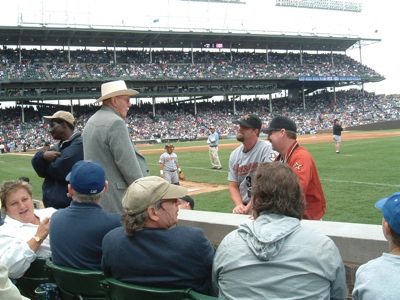
The fans at Wrigley can vary quite a bit. There are just as many hardcore fans at a game as there are at any baseball stadium (+1), but because of the popularity of the Cubs there are also a lot of casual fans. This leads to a lot of sellouts (+1), but also a lot of people who don't know much about baseball (-1). Luckily, the atmosphere of the stadium leads to a great experience (+1). The fans are right on top of the players so fans can let the visiting team know how bad they are (+1). The fans also seem more in touch with the game at Wrigley and it is not uncommon to see fans on their feet in the first inning (+1). Although there are a lot of casual fans at a Cubs game the atmosphere of the stadium makes up for the fact that not everyone knows what a balk is.
Score: 9/10
Ushers and Trading Up
The ushers at Wrigley all look like they have been on social security for the past decade, and for good reason...why would you give up a job that pays you to visit Wrigley Field every Cubs' home game (+1)? The ushers at Wrigley are generally the nicest people you are going to meet (+1), and if there are open seats later in the game they don't care in the least if you improve your view (+1). That can be tough when the Cubs are playing well, though, as the place is normally packed to the brim and they usually won't let you down in the front row of the box seats even when batting practice is going on (-1). The best thing about places like Wrigley and Fenway is that there are so few luxury boxes that celebrities mix with the common fan (+1), which is what baseball should be like. Some celebrities can be seen in the luxury boxes, but a lot of former players, notably former second baseman Ryne Sandberg, seem to prefer sitting amongst the fans (+1).
Score: 9/10
7th Inning Stretch
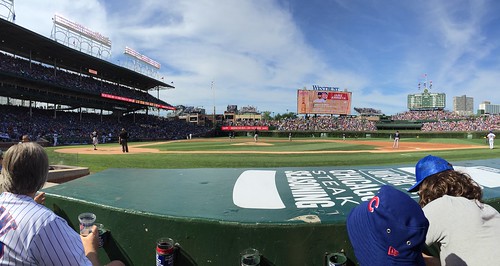
The 7th inning stretch began at Wrigley with the singing of "Take Me Out To The Ballgame," (+1) and while it used to be sung (off-key) by famed broadcaster Harry Caray (+1), it is now sung (usually off-key) by a parade of celebrities (-1) and everyday Chicagoans each day. Some moments such as Mike Ditka signing the song in record time and Ozzy Osbourne mumbling something other than "Take Me Out To The Ballgame" can make the 7th inning stretch an event in and of itself (+1). Nothing is better, though, than seeing some kids who just won the state championship for their high school up in the broadcast booth singing in front of 40,000 fans (+1). With the addition of the videoboard the number of celebrities touting their latest movie has been drastically reduced (+1) and videos of Cubs legends including Haray Caray, or former pitcher Ryan Dempster impersonating Haray Caray (+1), are played instead of a live singer.
Score: 10/10
Surrounding Area
The Cubby Bear (+1), Murphy's Bleachers (+1), The Sports Corner Grill (+1), and Sluggers, which has batting cages on the upper floor (+1), are just a handful of the great bars around Wrigley Field. Further away from the stadium are other, less crowded, hangouts such as Goose Island. Hanging out at any of them before or after a game is a great place to talk baseball with the legions of fans who probably don't even have tickets for the game. During the playoffs people will crowd the streets behind the ballpark just for a chance to be near the game (+1). You may even have a chance to see Ronnie "Woo Woo" Wickers, or other famous Cubs' figures just hanging out. Former Cubs' pitcher Rick Sutcliffe used to have an apartment above Murphy's Bleachers where he would pass out after all the partying he would do after games. There is no greater place to celebrate after a ballgame than Wrigleyville.
Score: 10/10
Final Score: 85/100

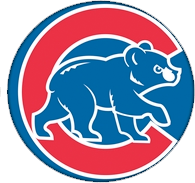
 Built in 1914 for the sizable sum of $250,000, Wrigley Field is now the oldest ballpark in the National League. The park was designed by famed architect Zachary Taylor Davis, who also designed the original
Built in 1914 for the sizable sum of $250,000, Wrigley Field is now the oldest ballpark in the National League. The park was designed by famed architect Zachary Taylor Davis, who also designed the original  In 1937 Bill Veeck, who would eventually go on to own the Chicago White Sox, St. Louis Browns, and Cleveland Indians at different times in his career, supervised the construction of the famous outfield scoreboard, which to this day has never been struck by a batted ball, although Roberto Clemente and Bill Nicholson both came close. Sam Sneed did hit the scoreboard from home plate, but he was using a driver and hitting a golf ball off a tee. A number of flags fly atop the scoreboard to show the current NL standings, and after a game a white flag with a blue "W" or a blue flag with a white "L" flies in their place to show El commuters whether the Cubs won or lost that day. 1937 was the same year the trademark ivy was placed on the outfield wall. Bill Veeck strung 350 Japanese Bittersweet plants from the top of the wall to the bottom, and also planted 200 Boston Ivy plants at the base of the wall. Eight Chinese Elm trees were also planted on the bleacher steps at this time to complement the ivy, but the winds blowing off of Lake Michigan kept the trees bare so they were removed. There were only a few major changes since that time. One major change was the reconstruction of the bleachers after the 2005 season. This expansion added 1,800 seats to the outfield, a private restaurant in center field called the Batter's Eye Lounge, and a gate on the outside of the stadium that allows passersby to see onto the field. One of the other major changes to Wrigley occurred in August of 1988, and it was a change that would affect Cubs' games for years to come.
In 1937 Bill Veeck, who would eventually go on to own the Chicago White Sox, St. Louis Browns, and Cleveland Indians at different times in his career, supervised the construction of the famous outfield scoreboard, which to this day has never been struck by a batted ball, although Roberto Clemente and Bill Nicholson both came close. Sam Sneed did hit the scoreboard from home plate, but he was using a driver and hitting a golf ball off a tee. A number of flags fly atop the scoreboard to show the current NL standings, and after a game a white flag with a blue "W" or a blue flag with a white "L" flies in their place to show El commuters whether the Cubs won or lost that day. 1937 was the same year the trademark ivy was placed on the outfield wall. Bill Veeck strung 350 Japanese Bittersweet plants from the top of the wall to the bottom, and also planted 200 Boston Ivy plants at the base of the wall. Eight Chinese Elm trees were also planted on the bleacher steps at this time to complement the ivy, but the winds blowing off of Lake Michigan kept the trees bare so they were removed. There were only a few major changes since that time. One major change was the reconstruction of the bleachers after the 2005 season. This expansion added 1,800 seats to the outfield, a private restaurant in center field called the Batter's Eye Lounge, and a gate on the outside of the stadium that allows passersby to see onto the field. One of the other major changes to Wrigley occurred in August of 1988, and it was a change that would affect Cubs' games for years to come.  Wrigley Field has been the origin of many popular baseball traditions. The first permanent concession stand was built at Weeghman Park in 1914 where it sold overpriced hot dogs and beer. It is said William Wrigley Jr. started the custom of allowing fans to keep foul balls, but that presumption is disputed by the Phillies who believe the tradition started in Philadelphia after a young fan was arrested for keeping a foul ball as a souvenir. In either case, the custom of fans throwing back opponent's homerun balls certainly started at Wrigley, and it continues today. Fans will even throw balls hit out of the stadium back from Waveland or Sheffield Avenues, to the chagrin of Reds' announcer
Wrigley Field has been the origin of many popular baseball traditions. The first permanent concession stand was built at Weeghman Park in 1914 where it sold overpriced hot dogs and beer. It is said William Wrigley Jr. started the custom of allowing fans to keep foul balls, but that presumption is disputed by the Phillies who believe the tradition started in Philadelphia after a young fan was arrested for keeping a foul ball as a souvenir. In either case, the custom of fans throwing back opponent's homerun balls certainly started at Wrigley, and it continues today. Fans will even throw balls hit out of the stadium back from Waveland or Sheffield Avenues, to the chagrin of Reds' announcer  "I'd pay half my salary if I could bat in this dump all the time."
"I'd pay half my salary if I could bat in this dump all the time."



